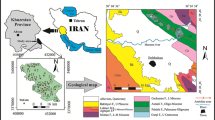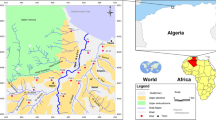Abstract
In urban areas, population growth generates significant amounts of wastewater which are treated in specialized treatment stations or rejected directly without control in the case of short water Bechar River. Because of their diverse backgrounds, these waters are often loaded with organic elements, minerals, and microorganisms; some of which could be harmful to health and is heavily involved in the degradation of groundwater that may be irreversible. The study was conducted on two boreholes located next to the Bechar River (north and south) by influencing wastewater localized on the course of the Bechar River. A work plan has been adopted; it is early to make a monthly monitoring of two wells during the period from January 2007 to April 2014, with a comprehensive analysis of physicochemical parameters, to determine the various anthropogenic contributions to polluting nature in the region and analyze their physicochemical composition, to explain the origin and evolution of each element. The analyses revealed the levels of Cl, NO3, NO2, NH4, and phosphates that can be passed to the groundwater by the water surface runoff of the river; the wastewater undergoes a slow percolation through the layers Triassic. This is confirmed by the high levels of chlorides, ranging from 180 mg/l in 2007 to 216 mg/l in 2014 for drilling north and 199 to 336 mg/l for drilling south of the river, which explains the values of the conductivity of 990 μS/cm ranging up to 1050 μS/cm. Nitrate concentrations ranged from 11 mg/l to 28 mg/l for the drilling located north of the river.
Similar content being viewed by others
Explore related subjects
Discover the latest articles, news and stories from top researchers in related subjects.Avoid common mistakes on your manuscript.
Introduction
The town of Bechar located in an arid Saharan region has a total contribution of average rainfall of 72 mm, and the volume of wastewater discharged through the drainage network of the city is estimated to 54,800 m3/day. It is known that in all Algerian cities, pollution problems of surface and groundwater are mainly caused by the following:
-
The discharge of wastewater into nature without purification
-
Lack of sewage and wastewater treatment systems
-
Irrigation of agricultural land by polluted wastewater
The supply of drinking water for the town of Bechar is provided by surface water and groundwater from aquifers and other groundwater unrecognized in the vicinity of the river source water discharges (risk of infiltration) (Kendouci 2012; Kendouci et al. 2013; Debieche et al. 2001).
The Bechar River was born in catchment areas of the Antar Mountain (1960 m) and Horreit (1461 m) (Bendida et al. 2013).
The Bechar River, by its infer flux on its path from north to south, crosses the outcrops of the following courses: Quaternary alluvium of old (of variable thickness between 5 and 10 m), the limestones of the Eocene said Barga II (greater than 60-m thick), the Turonian limestones said Barga I (25 to 45-m thick), the interbedded limestones and sandstones of the Carboniferous Westphalian, and, finally, a lateral contact with the alluvium of the Namurian (Kendouci 2012; Bendida et al. 2013).
Materials and methods
The measured physical parameters are pH, salinity, conductivity, and total dissolved solid (TDS). The chemical parameters determined are chloride, nitrate, nitrite, and phosphate according to standard analysis techniques. The assay methods used are as follows:
-
pH, salinity, TDS and conductivity, potentiometric method (consort 861).
-
Nitrate is determined by the potentiometric method (HI 121) using a specific electrode.
-
Ammonium AFNOR T90-015 on a filtered sample, blue method indophenols.
-
Nitrites, AFNOR 1986; phosphates, AFNOR NF T90-023 on a filtered sample by colorimetric method.
Sampling campaigns
The river is along the city of Bechar both sides along its entire length, where the wastewater is discharged into several discharge points. The study was conducted on two boreholes located next to the Bechar River:(drilling north and south) (Table 1) by influencing drilling wastewater localized on the course of Bechar River (Kendouci 2012; Kendouci et al. 2013).
A work plan has been adopted; it is early to make a monthly monitoring of two wells during the period from January 2007 to April 2014.
The choice of sites was set a preliminary study of physicochemical parameters, and the direction of the flow of the river is from north to south (Fig. 1).
Parameters (temperature, conductivity, pH, and salinity) were measured in situ using a multiparameter (consort 861) (Rodier 2005; Al Shaibani 2008; Degremont 1978; Franck 2002).
Results and discussion
The results of this study are explained in discussing the parameters measured, including in situ measurements and those made in the laboratory. We quote the average results for the two semesters each year, S1: first half (winter) and; S2: second half of the year (summer).
Conductivity
Conductivity is related to the presence of ionic species in solution. The years 2013 and 2014 shown in Fig. 2 show the largest conductivities, 1060 μS/cm for the drilling north and 1020 μS/cm for the drilling south; electrical conductivity increases from 870.2 μS/cm (2007) to 1020 μS/cm (2014), with the rate of increase to 25 % for drilling in the north and 16 % in the south, during 7 years.
Potential hydrogen (pH)
All drillings show alkaline pH; there is a slight variation in pH of both drilling and this may be due to the origin of the sandy terrain (Kendouci 2012) (Fig. 3).
Nitrate
Nitrate represents the highest form of oxygen with nitrogen as a highly soluble form. Its presence in groundwater is related to the intensive use of chemical fertilizers. The years 2012, 2013, and 2014 shown in Fig. 4, show the most important levels, respectively, 26 mg/l for drilling north and 28 mg/l for drilling south; the content of nitrate in 2007 was 8 mg/l. The rate of increase during the last 7 years is around 70 %; this increase is related to the effect of urban waste and the effect of stagnant water in the river (Fehdi et al. 2009; Abdelkader et al. 2012).
Nitrite
The passage between nitrate and ammonium is a toxic form. We note the absence of nitrite in both drilling during the first 4 years of the study; the highest average values are observed in 2011, a level of 0.025 mg/l in drilling north and 0.02 mg/l in drilling south (Fig. 5) (Tandia et al. 1999; Kendouci et al. 2013; Li et al. 2008).
Ammonium
Ammonium results from human activities, agricultural wastes, or discharges and industrial waste. The maximum values are recorded in 2013, 0.02 mg/l for drilling south and 0.025 mg/l for drilling north of the river (Fig. 6).
Chloride
The concentration of chloride undergoes an increase of 180.7 mg/l in 2007 to 218 mg/l in 2014 for drilling north and a value of 290 mg/l for drilling south (Fig. 7). The increase in the contents of south drilling due to the infiltration of wastewater in the river to the groundwater (Fehdi et al. 2009; Elouazzani 2005).
Phosphate
Total phosphorus is largely due to domestic activities and agricultural and industrial activities. Drilling south recorded maximum values of total phosphate in 2013 and 2014 (0.01 mg/l). Drilling north takes one value of 0.01 mg/l in 2014 (Fig. 8). The presence of phosphate is related to the effect of urban discharges and the effect of stagnate water in the river (Hazourli et al. 2007; Kendouci 2012).
Conclusion
The results obtained in this study (physicochemical analysis) show that the majority of groundwater contamination by sewage from the river is by caused infiltration process that depends likely on soil and climatic environmental factors, and that treatment of urban waste is essential to protect groundwater and the ecosystem.
With maximum levels of 28 mg/l nitrate, 0.02 mg/l nitrite, and 290 mg/l chloride, this study allowed us to demonstrate the existence of several chemical pollutants in groundwater.
Groundwater is subjected to several effects of pollution by the natural effect of salinity with high concentration of Na+, Cl−, and Ca2+ and agricultural pollution is marked by the high concentration of NO3 and also by the relation river-aquifer allowing infiltration of the river to the groundwater.
References
Abdelkader R, Larbi D, Rihab H et al (2012) Geochemical characterization of groundwater from shallow aquifer surrounding Fetzara Lake N.E. Algeria. Arab J Geosci 5(1):1–13
AFNOR, French Association for Standardization (1986) Water test methods, 2nd edn. Collection of French standards, Paris
Al Shaibani AM (2008) Hydrogeology and hydrochemistry of a shallow alluvial aquifer, Western Saudi Arabia. Hydrogeol J 16:155–165
Bendida A, Tidjani A, Badri A, Kendouci MA, Nabou M (2013) Treatment of domestic wastewater from the town of Bechar by a sand filter (sand of Beni Abbes, Bechar, Algeria). Energ Proc ELSEVIER 36:825–833
Debieche TH, Mania J, Mudry J (2001) Pollution of a water table by chromium and tin from a storage metallurgical residues: application to the lowlands Seybouse, North-East Algeria. Africa Geosci Rev 8(4):451–461
Degremont (1978) “Technical water Memento”, Eighth Edition, France
Elouazzani D (2005) “Physicochemical characterization and optimization in building and construction of ash from the incineration of paper mill sludge” Ph.D. Thesis, Institute of Applied Sciences Lyon
Fehdi C, Boudoukha A, Rouabhia A, Salameh E (2009) Chemical characterization hydro groundwater aquifer complex Morsot-Laouinet (Northern Region Tébessa, South Eastern Algeria). Africa Sci 05(2):217–231
Franck R (2002) Water analysis, regulatory and technical aspects. Scérén CRDP AQUITAINE Edition. Bordeaux 165–239
Hazourli S, Boudiba L, Ziati M et al. (2007) Characterization of wastewater pollution of the industrial area of Al-Hajar, Annaba. LARHYSS J. ISSN 1112–3680, No. 06, 45–55
Kendouci MA (2012) Development of local materials for wastewater pretreatment. Magister Thesis, University of Bechar, Algeria
Kendouci MA, Kharroubi B, Maazouzi A, Bendida A (2013) Study of physic-chemical quality of wastewater discharged into the natural environment the case of Bechar River Algeria. Energ Proc 36:287–292
Li Z-P, Cao L-H, Chen X-G, Shen Z-L, Zhong Z-S (2008) Influence on shallow ground water by nitrogen in polluted river. Desalination 14:103–108
Rodier J (2005) The analysis of natural water, wastewater, seawater. 8 the Edition technical Dunod, Paris 1008–1043
Tandia AA, Diop ES, Gaye CB (1999) Nitrate pollution of groundwater in non-sanitized semi-urban environment: example of the web Yeumbeul, Senegal. J Afr Earth Sci 29(4):809–822
Acknowledgments
The authors would like to express their gratitude to the MESRS of Algeria, for the support.
Author information
Authors and Affiliations
Corresponding author
Rights and permissions
About this article
Cite this article
Kendouci, M.A., Kharroubi, B., Mebarki, S. et al. Physicochemical quality of groundwater and pollution risk in arid areas: the case of Algerian Sahara. Arab J Geosci 9, 146 (2016). https://doi.org/10.1007/s12517-015-2221-9
Received:
Accepted:
Published:
DOI: https://doi.org/10.1007/s12517-015-2221-9












